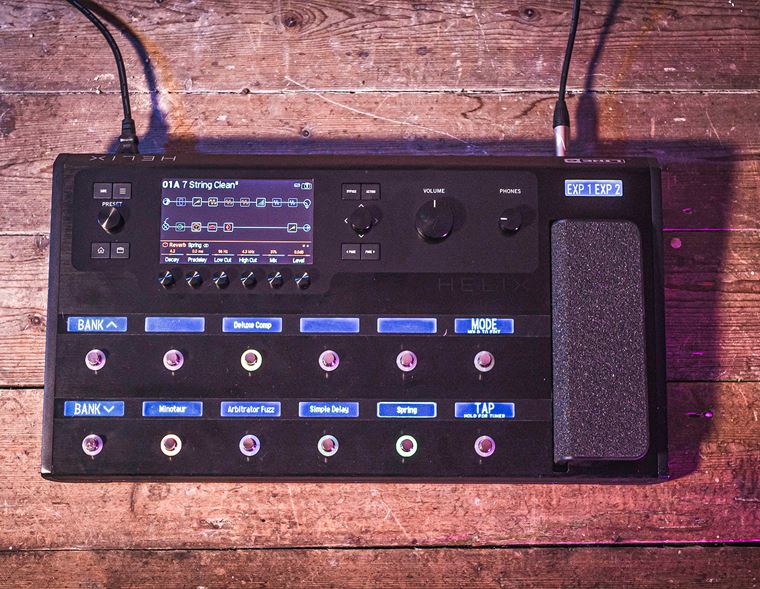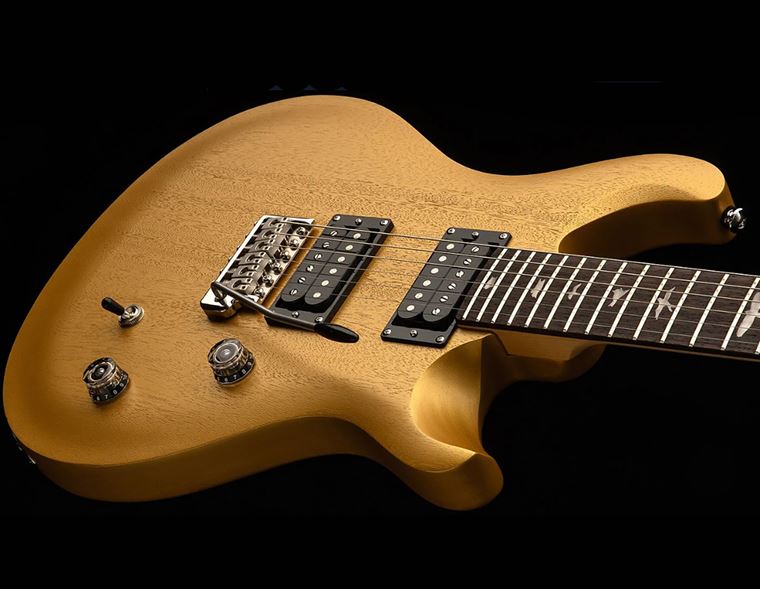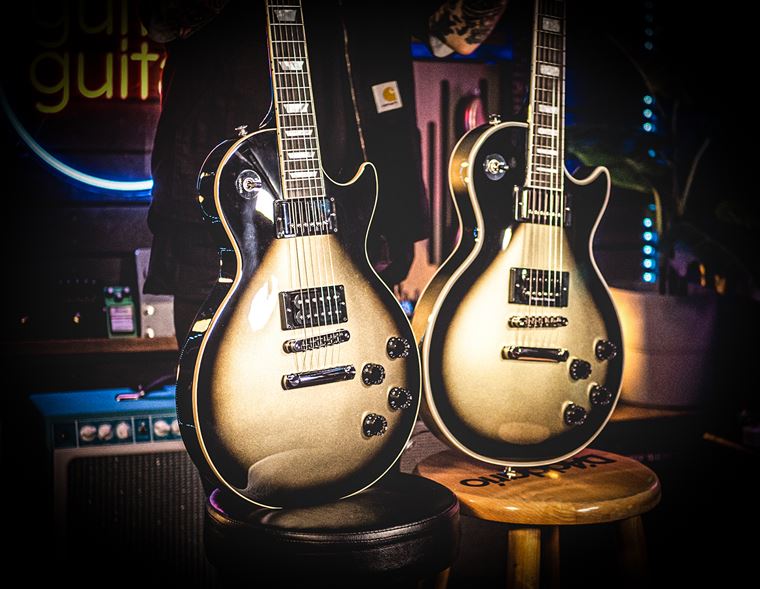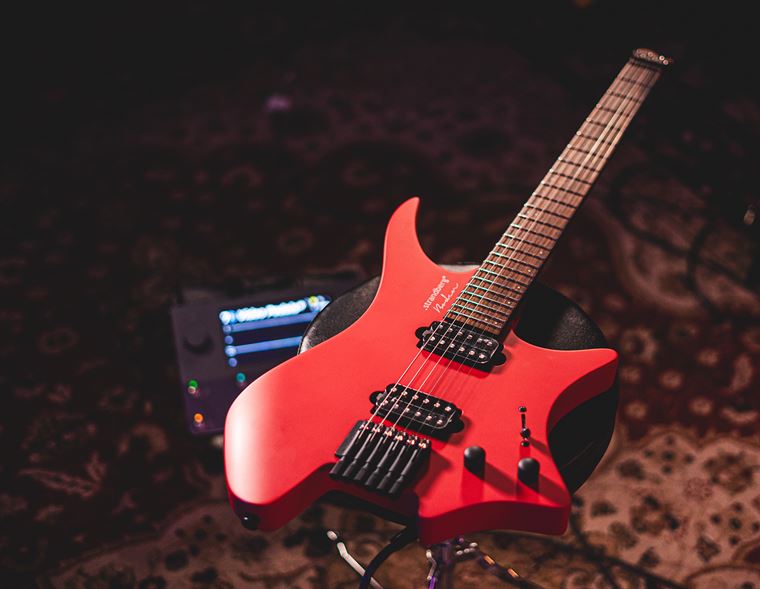The Best Electric Guitar Finishes EVER
What kind of guitar fan are you?
Are you a person who loves seeing a select sliver of highly figured timber proudly peeking through a delicious translucent finish?
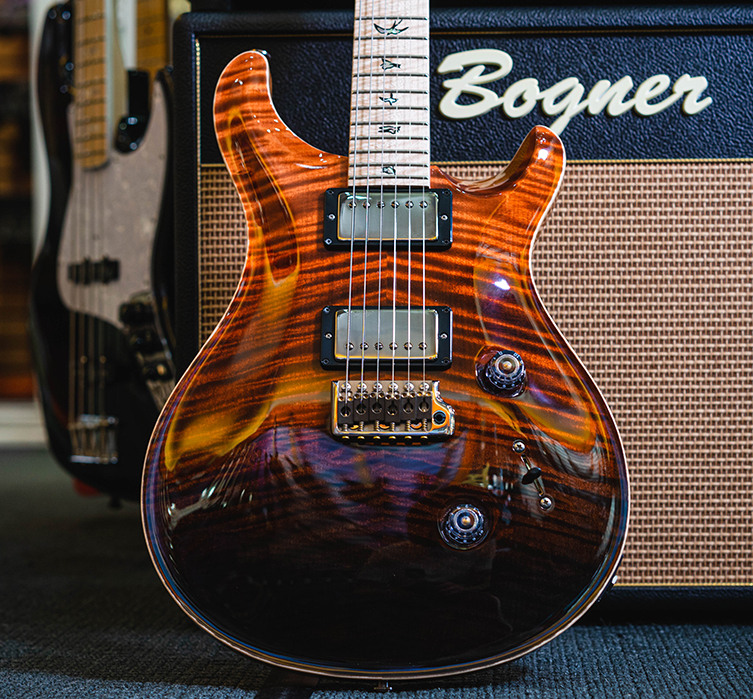
Or are you a fan of a bold, highly contrasting graphic art finish?

Perhaps you like texture as much as colour? Maybe you even like things simple and straightforward in terms of colours and finishing?
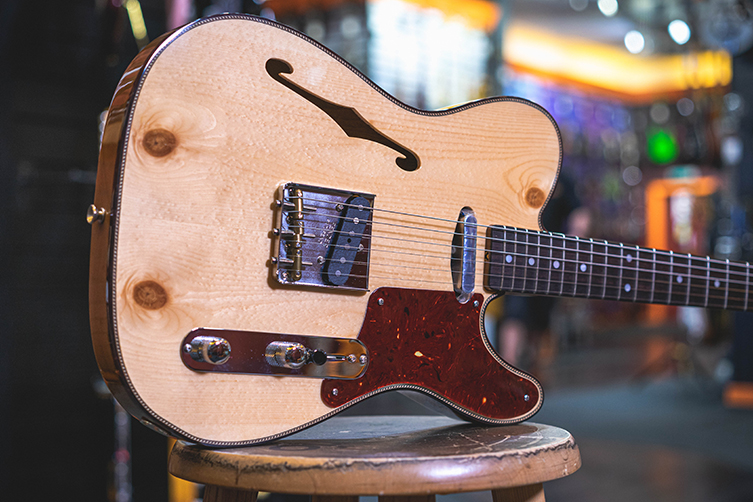
All of these perspectives are totally valid, and all have their place in the guitar market. After all, the guitar is such an expressive instrument already, so it just makes sense to apply more expression to how it looks, right?
The All Time Greatest Guitar Finishes
This blog aims to highlight a good cross section of the many wonderful ways of finishing a guitar that exist out there. We’re taking in as much of a variety as we can, and it’s not all about crazy stuff, either (though there’s plenty of crazy stuff, worry not!). Starting near the dawn of time itself, the 1950s, we’ll look at iconic finishes that are regarded as pretty normal these days, and move into the more esoteric material as we travel along our path. There will be swirls, fabrics, sparkles and even full-on bronze happening on this blog before we’re done!
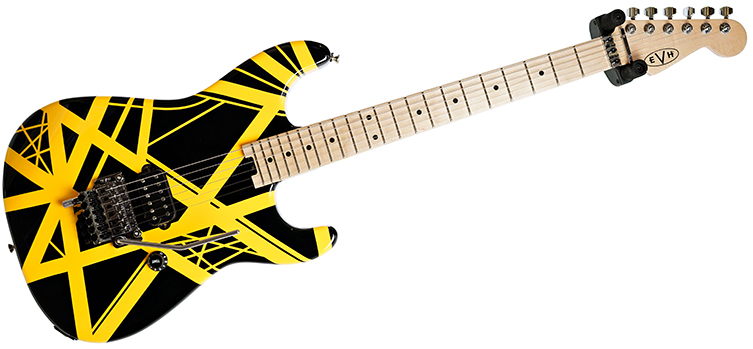
Gibson Goldtop
Gibson’s first available finish for the Les Paul is also one of their coolest. Also found on their impossibly lovely ES-295 hollowbody (well known to Killing Joke fans), the Gibson method of creating their gold tops was to grind up bronze powder and mix it with a clear lacquer. Apparently it was quite a difficult process to achieve continuity with, as the bronze particles tended to behave rather differently under certain lighting situations.

One of the best features of a Goldtop finish is actually how it decays, believe it or not! The finish has always been known to crack and flake somewhat (Gibson say it’s on purpose since there’s no way to counteract it), but it also takes on a slightly green hue in some places after decades of wear. This is because the copper in the finish oxidises after the clear coat eventually wears away, and it’s beautifully dramatic looking. Sadly (in our opinion), recent years have seen Gibson change from the copper powder to gold mica chips, so only vintage examples will ‘green up’, as it were. Old Goldtops are like pieces of fine art, and are justifiably sought after, especially given the ever diminishing numbers available.
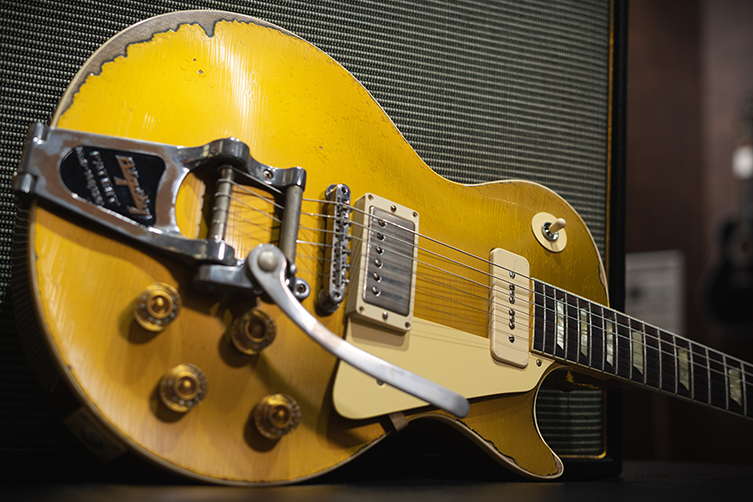
Gibson Sunburst
You’ll be forgiven for thinking, as you lovingly gaze through all of the various ‘Burst’ permutations that Gibson offers nowadays, that there has always been a huge choice of such a colour. Not the case at all, in fact! Indeed, back in 1958, there was but a single offering entitled ‘Sunburst’, which would be what Gibson would nowadays call ‘Heritage Cherry Sunburst’.
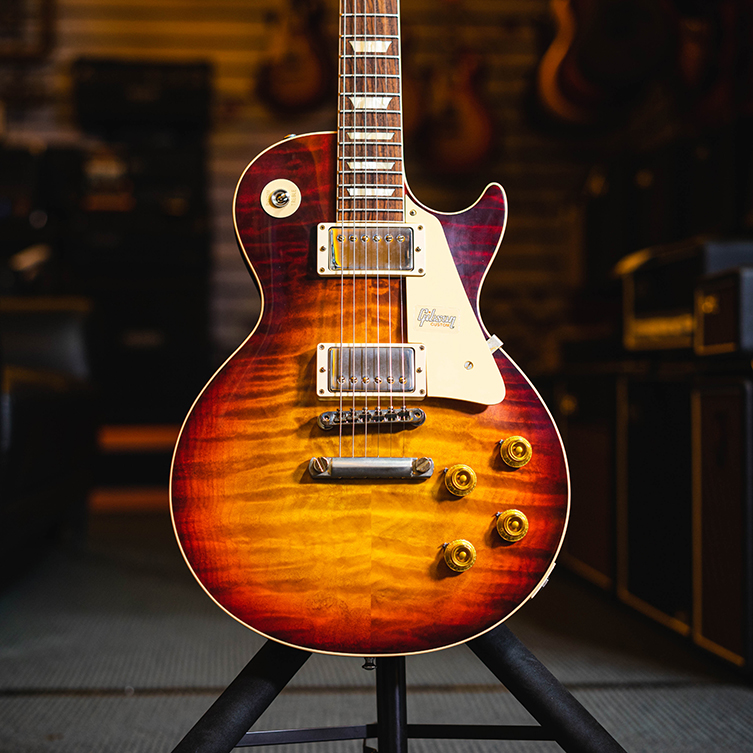
The reason for all of the variants lies in the materials used in the process. Like Fender, Gibson often stained the tops of their guitars with a translucent yellow/amber colour. Unlike Fender, who used more opaque colours for the surrounding ‘burst’ effect, Gibson used a translucent red coat next. Afterwards, a nitrocellulose lacquer was sprayed on in several thin coats, and then left to dry.
So far, so normal. The real story doesn’t begin until each Les Paul had accrued a few years’ mileage out in the real world. Environmental effects such as sunlight and cigarette smoke had their way with the Sunburst finishes in a number of ways. Sunlight would make the cherry red paint fade to a milder orange and then disappear completely, as Peter Green fans would certainly recognise. Some Les Paul owners would take off their pickguards and find strong red colour surviving when the rest of the top had faded away!
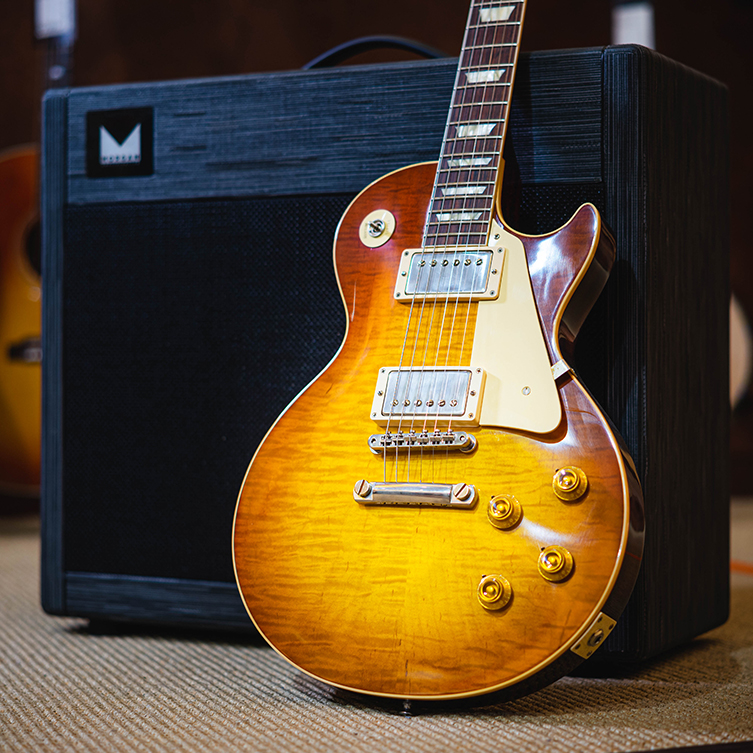
Cigarette smoke would darken the finish, though ‘tobacco burst’ was in fact a new colour that was introduced later on in the guitar’s history! Smoke also darkened the plastic binding around each Les Paul, which is something you can more obviously see on Les Paul Customs, where older models show yellowy beige binding instead of the factory-supplied white.
Today, Gibson fully understand the scope of colours and effects they can get just by varying their basic Sunburst finish, so you can buy one that looks just as you want it, without having to wait 60 years for nature to take its course!
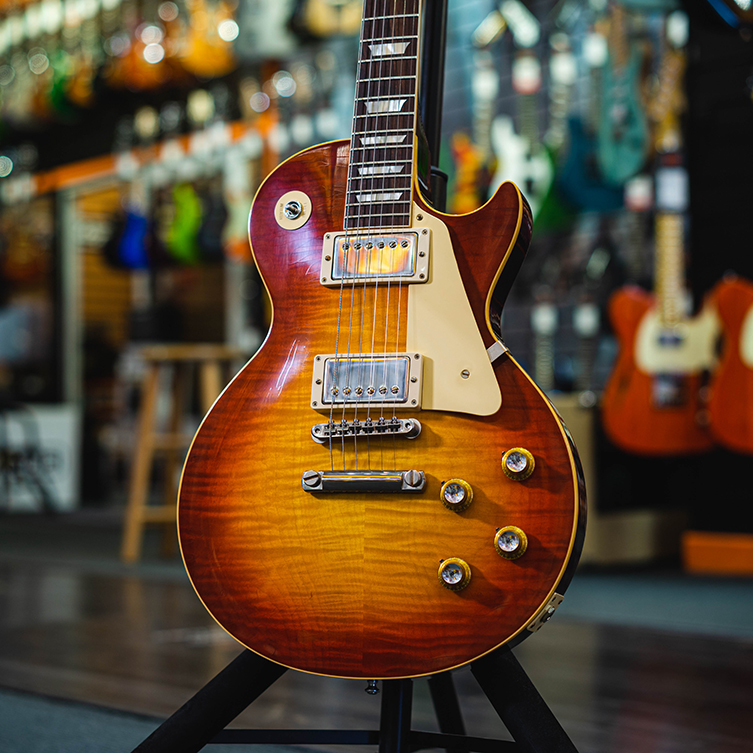
Paisley Finish
Given that it’s an extremely famous finish, it’s easy to forget how crazy looking a paisley finished guitar actually is! Country fans love it too, which is even more surprising, given how visually conservative that genre tends to be.
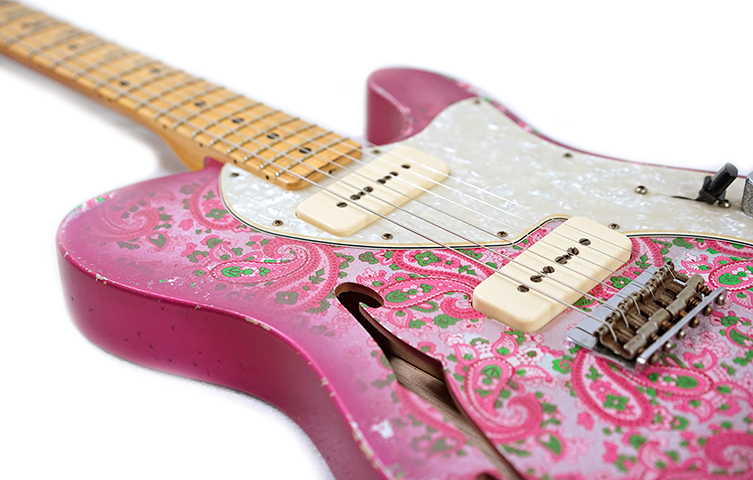
That said, it’s a wonderful look and we love it! What’s even cooler is how the paisley look is achieved. So, the quick explanation is that the ‘paisley’ design in indeed from the city of Paisley in Scotland (it’s actually an ancient Persian design, but paisley was where loads of fancy shawls and scarves were made with the pattern, so they somehow get the glory), and the finish is achieved by using a piece of paisley patterned wallpaper (we kid ye not), carefully arranged on the guitar’s face in order to make the most of the design, and then glued down in place. The paint - traditionally pink but you’ll see many iterations nowadays - is then sprayed around the edges of the guitar, in the same way that a sunburst finish is achieved. This also helpfully disguises the ‘evidence’ of the paisley paper’s edges.
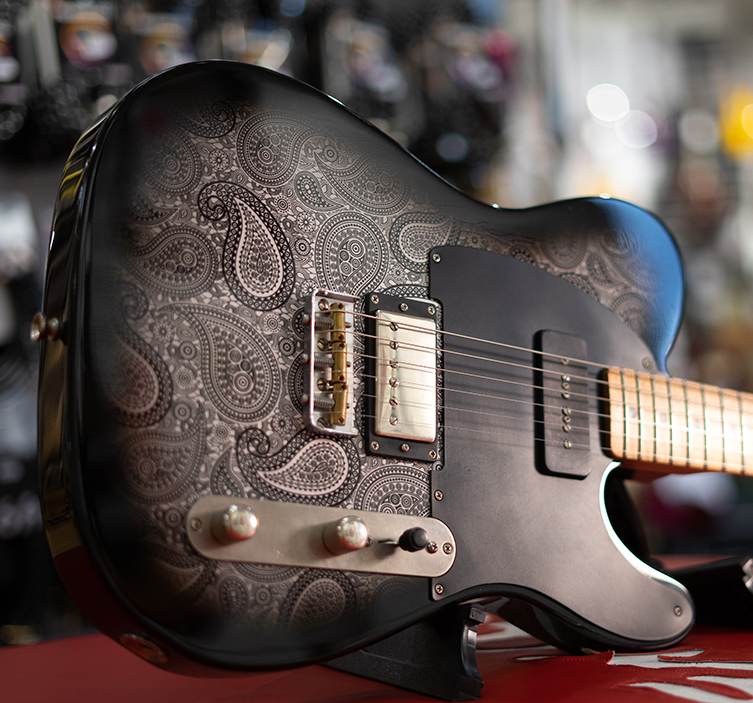
So, there you have it: you basically wallpaper a guitar and then spray some paint over it before sealing it with varnish. Easy!
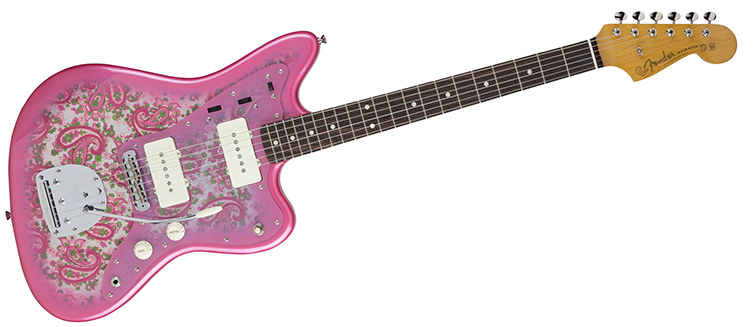
Ibanez JEM Floral and Swirl
Ibanez know a thing or two about attention-grabbing finishes, particularly where their top endorsee Steve Vai is concerned. It seems that Steve has just never been interested in playing a generic looking guitar, and Ibanez have been only too willing to satisfy his outlandish requests.
Bearing in mind the paisley finish we just looked at, one of Ibanez’s most enduringly loved guitars is the floral JEM77. This was the first - and best known - of a number of floral designs that Steve had made over the years. The attractive Japanese flower design, by designer Jay Yang, was actually on a set of curtains that hung in Vai’s home. Feeling inspired and seeing a direct course from A to B, Vai simply took his curtains into the Ibanez Custom Shop in LA and requested they ‘do a paisley’ and use the fabric directly on one of his signature JEM guitars. The results were pretty excellent, and so a few more have appeared over the years in blue and black guises, too.
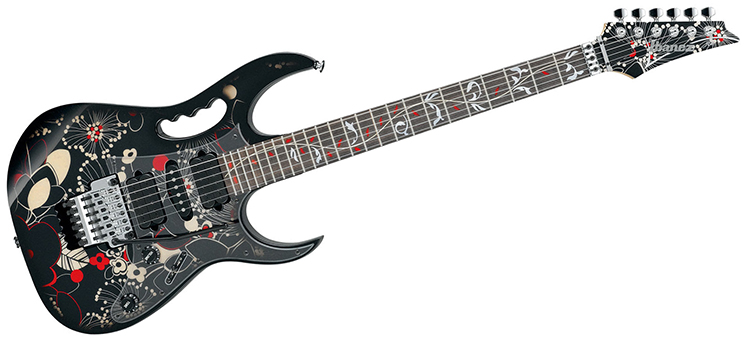
The Swirl finishes, on the other hand, are more Jackson Pollock than curtain couture. The first swirls we saw were the bowling ball style finishes Vai had on his initial Universe 7 string models. These are extremely dramatic looking and of course no two are ever the same. To achieve a swirl finish, the guitar’s body is literally dipped into a tub or container filled with water, a little borax (to break the water surface tension that will otherwise prevent the paint doing its thing) and a selection of paint. The paint itself can be oil, enamel or urethane (though stay consistent!) and is added dark to light before being swirled and manipulated with a stick prior to dipping.
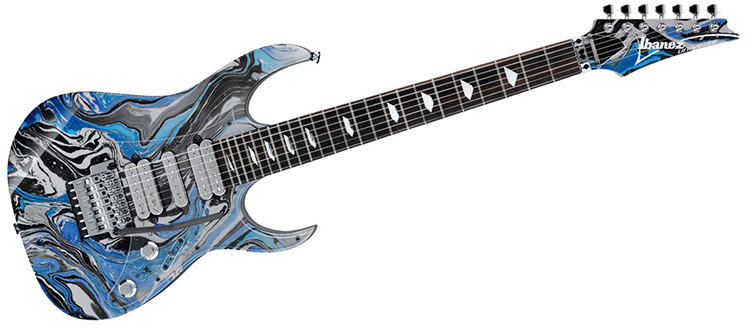
There’s more to it than that, but not too much! The end result is an effect you just cannot get in any other way, and it’s pretty stunning. Vai, being Vai, took this a step further with a special Anniversary model that had flourescent swirls inside an entirely see-through acrylic resin body! You can't say he doesn't follow through on his ideas, can you?

(pic: Michael Mesker)
PRS 10 Top Stain Finishes
PRS are of those guitar brands you’d buy a calendar of, such is the well-known beauty of their creations. ‘Regular’ PRS guitars are wow enough, but when you get to the likes of their 10 Top instruments, we’re talking eye-popping levels of prettiness.

A lot of this is down to them using spectacular slices of figured wood for their tops, but that’s not the whole story. The top of, say, a Custom 24 is also elegantly carved, and has violin-inspired contours around the edge of the body. Then, they also have exquisite colour work added by hand, by staff that use rags and sponges. It’s quite an experience to watch this type of loveliness emerge: the artisans who work at PRS have attained their quiet confidence through decades of dedicated work, taking 5 minutes to do what would take another person a month.
Crazy 1980s Graphic Finishes
We actually dedicated an entire blog to the most ostentatious graphic finishes that have existed within the guitar community, but it’s definitely worth revisiting some right here! The more hard rock/metal guitar brands like ESP, Kramer and so on seem to be the ones who love decorating guitar bodies with graphics, perhaps befitting a genre of music that takes advantage of electric guitars more than any other instrument.

Over the years, we’ve seen a myriad of wild graphics, from dragons to skeletons, album covers to even your favourite fictional karate dojo. Bow to your sensei!
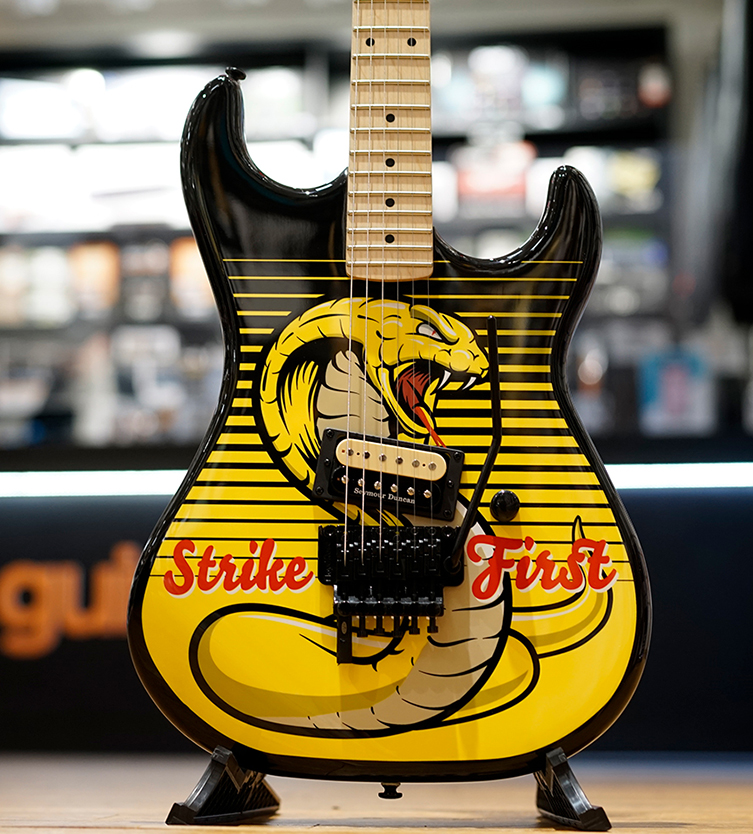
Rather like wearing your favourite band’s t-shirt, a graphic finish guitar helps proudly announce your allegiance to the metal hordes. Some of these guitars, like the Jackson Adrian Smith model below, are actually hand-painted one at a time, with an airbrush and a lot of dedication!
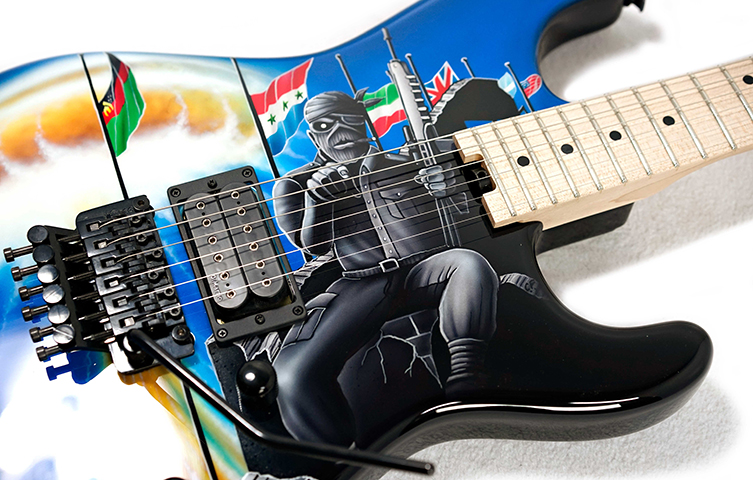
Special Mention for Kirk Hammett
Before we leave the subject of graphic finish guitars, we feel the need to single out the heroic commitment to graphics shown by Metallica’s lead shred maestro. His taste for occult imagery and classic horror movies have resulted in a high number of excellent looking - not to mention pretty iconic - guitars.
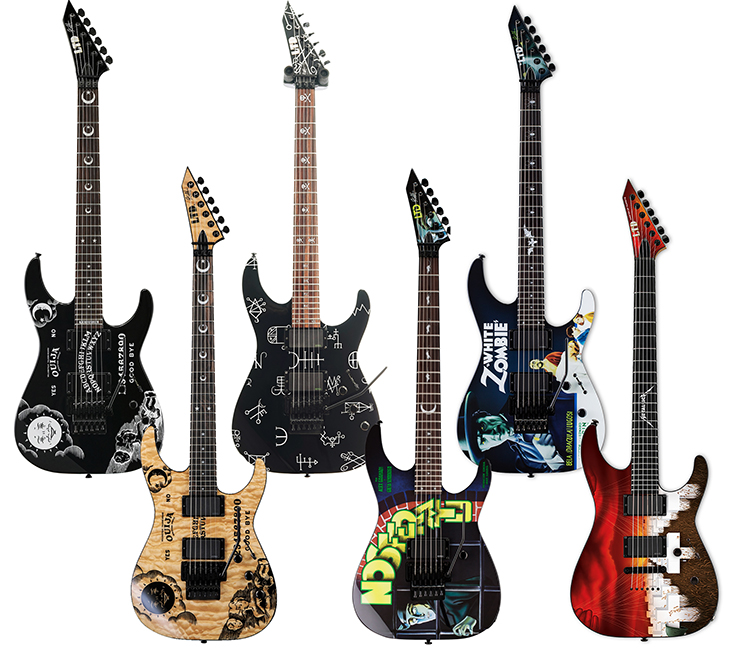
Favourites? Well, we like them all, but for us it’s a toss up of either his Boris Karloff Frankenstein effort or his uber-famous Ouija board (don’t try it at home, kids) guitars. What’s next for the legend? Surely we’ll find out soon, but in the meantime he seems to be pretty happy with his OG Peter Green Les Paul (yep, that ‘59 Les Paul goes on stage every night with Metallica) and his army of ESP KH models.

Tyler Schmear/Burning Water
Tyler make some of the most recognisable top-end guitars on the market. They may be superficially based on S and T style guitar designs, but you’d never mistake a Tyler for any other brand. If the ‘pointing fingers’ headstock doesn’t tip you off to the fact that you’re no longer in Kansas, so to speak, then the elaborately OTT ‘schmear’ finishes will make this fact abundantly clear!
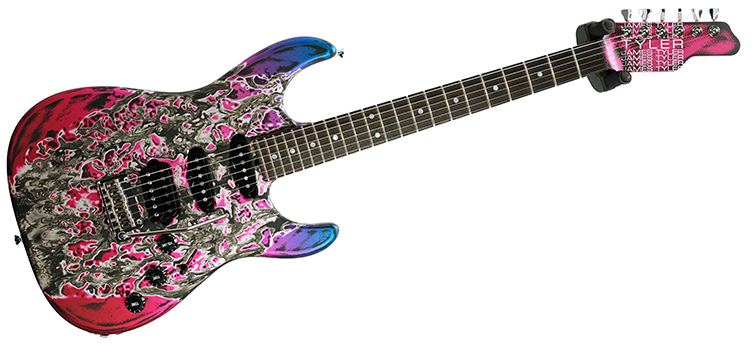
For his fans, James Tyler’s guitars are the greatest examples of the S-type known to man. We’re in no hurry to disagree, frankly, but today is all about finishes, and these Schmears have become legendary. Take a second and have a good look at one of these accompanying pictures. Check out the mixture of solid colour, metallic pigment, stain, bare wood and…well, we’re not really sure what else, to be honest! The process of achieving such a look is a ferociously well-guarded secret, too. Let us just say that anybody explaining how to do it on an internet guitar forum is not getting it right at all (it is most definitely not a case of painting 5 colours and then sanding!).
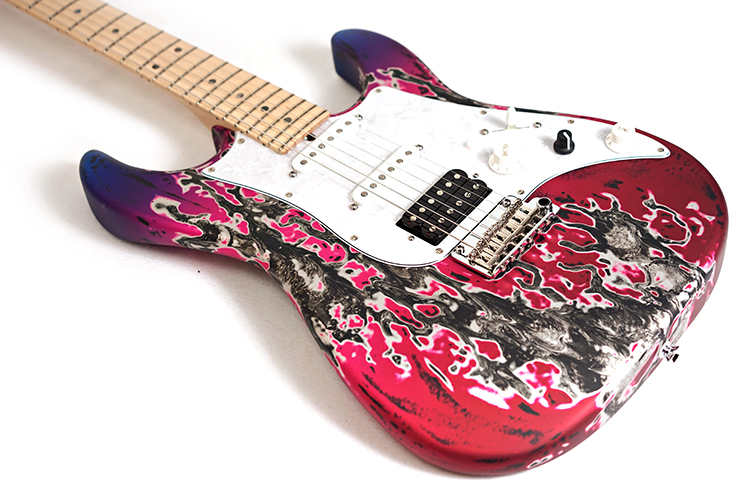
What’s obvious is that nobody else can do it, since we never see any finishes like this except on Tyler guitars. It’s such a well-kept secret, in fact, that even the luthiers who build Tyler’s Japanese instruments were not taught the process until recently! However it’s done, it’s exceptionally distinctive and totally wild looking.
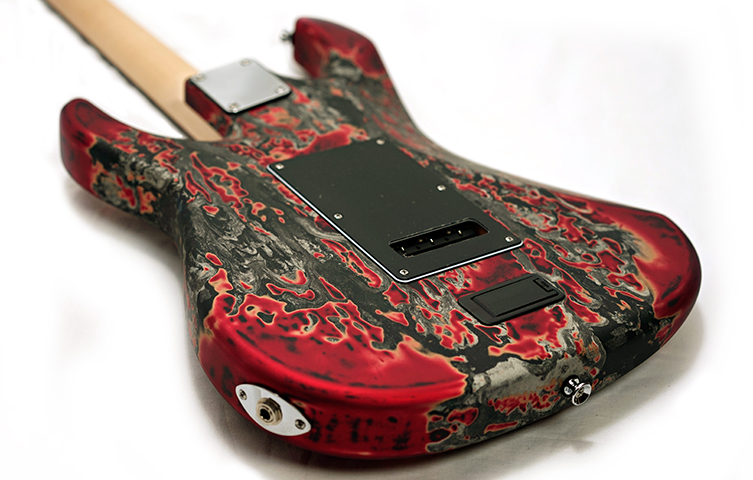
Silverburst
Silverburst is one of those finishes that has a lot of mythology spoken about it. Mostly, this is down to Tool’s Adam Jones, who is a lifelong Silverburst acolyte. We’ll get back to him in a second, but firstly, silverburst is a metallic finish made famous by late 70s Gibson guitars, particularly the Les Paul Custom and even more particularly, those created between roughly 1978 and 1982.
Ostensibly, it’s simply a silver finish with a burst of black around the edges. Unlike Gibson’s Goldtop method of using ground copper powder (see top of article), the ‘silver’ is in fact metallic paint. Back in the late 70s, it was silver Buick car paint, which contained chromed aluminium. Nowadays it’s chromed polyester, which is the point where we start falling down the rabbit hole…
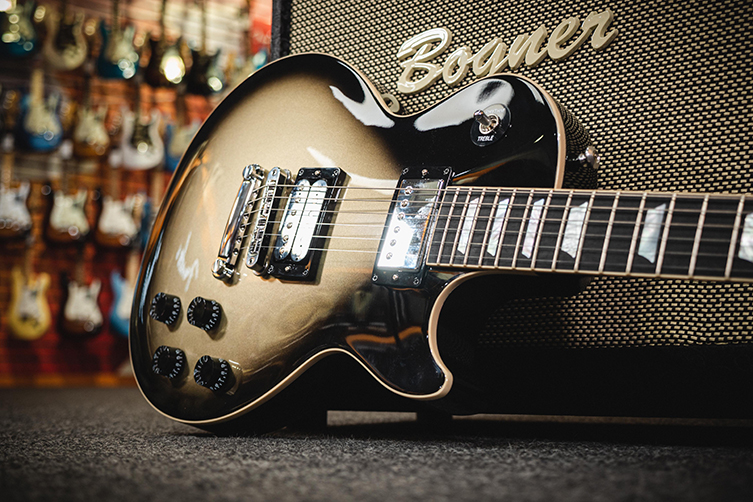
You see, there’s an increasing number of players/collectors/bloggers who believe that Silverbust guitars (okay, Silverbust Les Paul Customs) sound better than guitars of the same spec that have different finishes. We’re really not too sure about this at all, but for the sake of a fun read, here’s the lowdown: some say (this would be Tool’s Adam Jones again) that the paint is heavier than standard colours, and hence adds to the weight of the tone; some others maintain that the tiny metal chips in the paint affect the magnetic pull of the pickups. We’d be down with that last one, if it weren’t for the fact that neither aluminium nor chrome are in any way magnetic. Still, we suppose there could be a tiny argument for things like magnetic reflection and so on, but that’s getting a little desperate.

However it affects or doesn’t affect the sound of the guitar, Silverburst is one awesome looking finish! One other cool thing to note is that the silver on these old examples does definitely change colour to green after a few decades. Presumably it’s due to the metal flakes oxidising, just like on the old Goldtops.
Dipped in Bronze
If we are on the subject of metal being used in finishes, then Robbie Robertson’s ‘Last Waltz’ Stratocaster takes home the prize for sure. Prepping for The Band’s farewell show, Robertson knew he needed something special to play since the show was being filmed for posterity by Martin Scorcese. Taking one of his favourite Fender Strats (a red 1954 example), he literally had the body dipped into bronze. It’s extraordinary looking, especially up close where you can see that the bronze has actually penetrated the wood of the body. You can see the grain through the bronze!
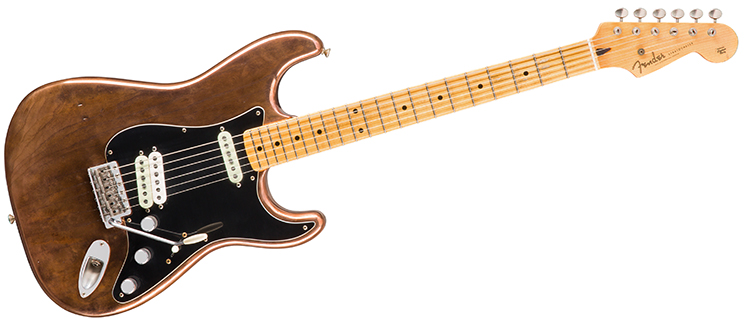
Fun fact: that is not actually a bridge humbucker on there: Robertson simply didn’t like having the Strat’s middle pickup getting in the way, so found a left-handed bridge pickup and had it installed upside down, right next to the existing bridge unit!
Mirrors and Mosaics
Guitarists love shiny finishes, particularly if they spend a lot of time on stage. Instruments that reflect lights back out in cool ways add plenty to a musician’s stage presence.
Joe Satriani knows this well. One of his most famous signature models from Ibanez is his ‘Chromeboy’, a JS model covered entirely with smooth chrome. Is this his most recognisable guitar? We think so, and it plays to his 'alien of rock' vibe perfectly.
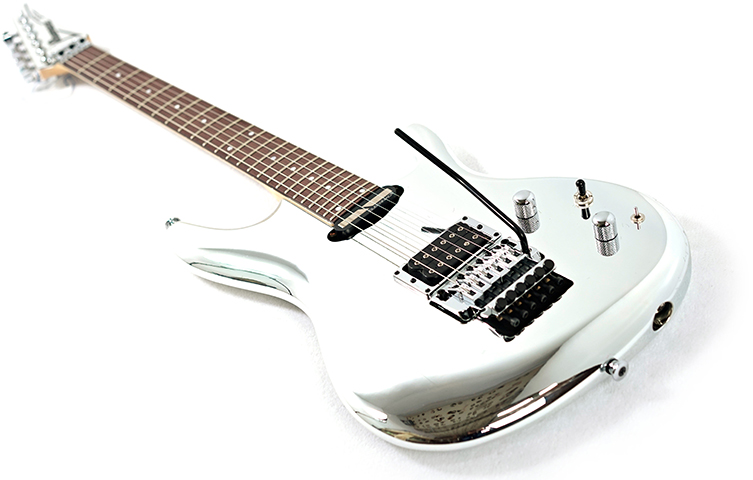
Zemaitis guitars are a semi-mythical brand of British made guitars that are amongst the most decorative that we’ve ever seen. We’re talking full-on mosaic work here, like the sort of thing you’d see on the walls and floors of an ancient Greek palace! Zemaitis guitars were created by Tony Zemaitis and have been played and cherished by the likes of Ronnie Wood and Fall Out Boy.
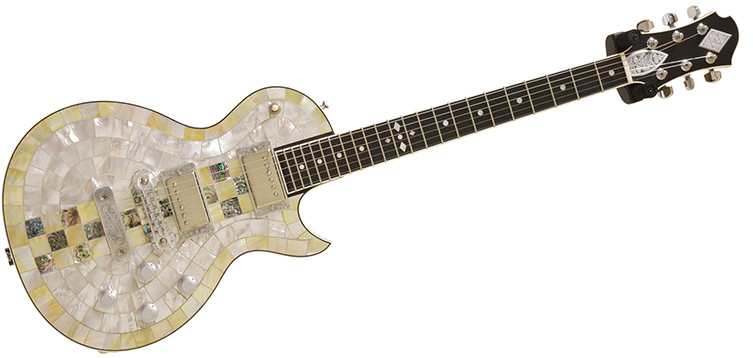
Mirrors are an obvious choice for those who want their guitars to glow like lightsabers on stage. One such flagrant showman is Paul Stanley, who already wins points for popularising Ibanez’s grievously underrated Iceman shape. This ‘cracked mirror’ finish throws reflections in all manner of directions, for even more bonus points!
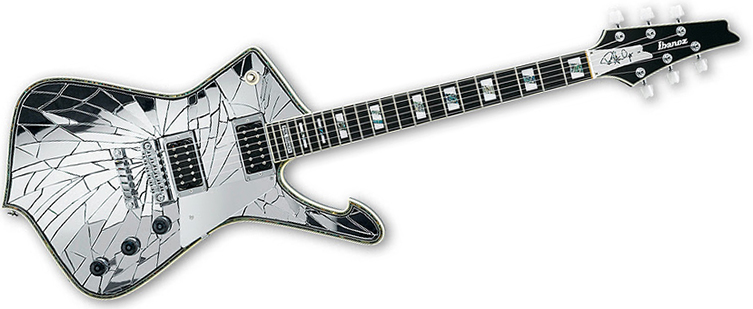
Another player who hopefully hasn’t earned themselves seven years of bad luck is former Megadeth axe-wonder Marty Friedman. His Jackson signature model here sports another cracked mirror finish, and goes one step further by making the shards purple! A sunburst Strat this is not.
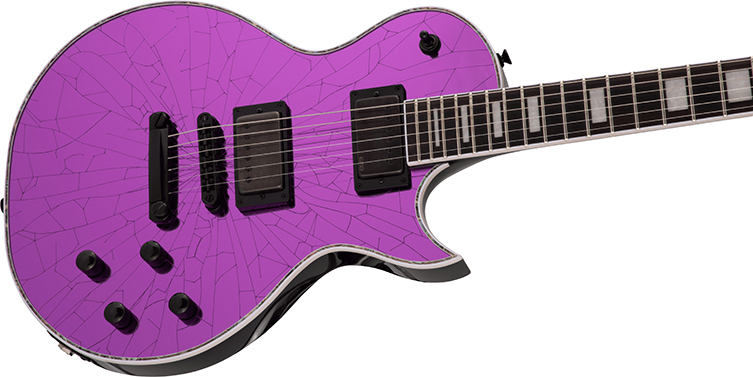
The Guitar is a Canvas
What a colourful world we guitarists live in! Even if you prefer a slightly more sober finish for your own instruments, we’re pretty sure you can get a kick out of this kaleidoscopic collection of jewels on display today. Our guitar choices say much about our personalities - whether we are conscious of that fact or not - and today’s blog hopefully goes to show that no matter how eccentric or extrovert you may be, or how subtle and minimal you are, there’s a guitar out there that represents how you see music.

Trends may come and go but the guitar will always remain, and they are a great reflector of the times they are made in. From the copper-powder Goldtops of the fifties to the carefully hand-stained wonder of today’s top PRS models, there’s such a wealth of beauty and cool information to take in on this subject!
We may never really know how to create a Shmear finish, and we may never definitively learn whether those metal flakes in a Silverburst finish really affect the tone, but we’ll have a lot of fun along the way! And remember: style never goes out of style!




